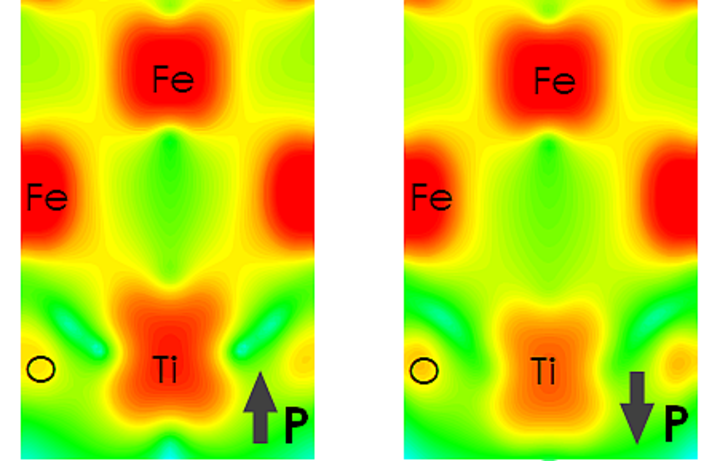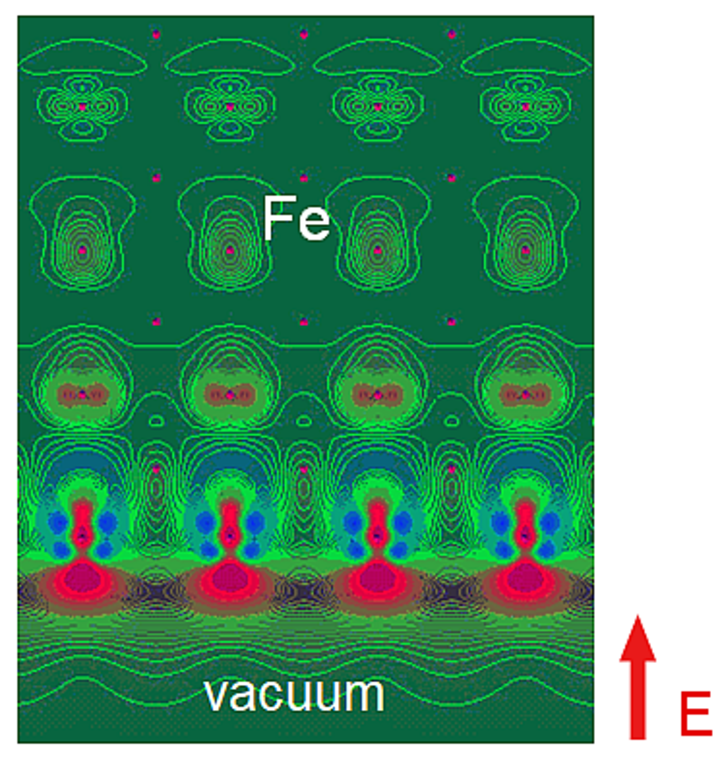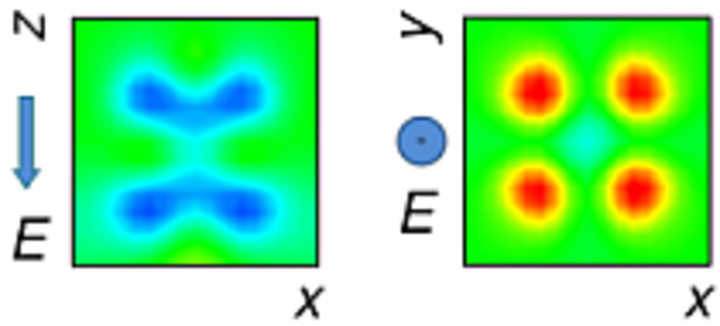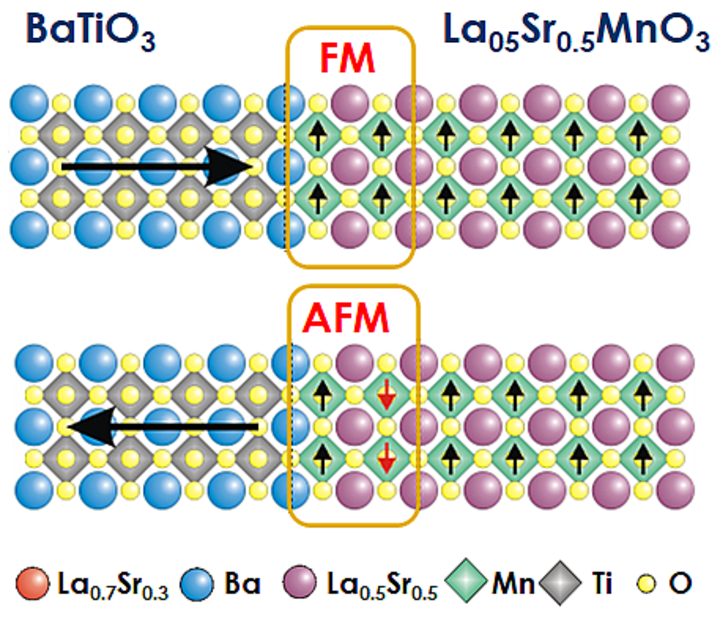Control of magnetic properties of materials by an applied electric field, known as magnetoelectric coupling, is interesting for low-power spintronics. There are several known mechanisms responsible for magnetoelectric coupling including intrinsic effects in single-phase materials, strain induced coupling in two-phase composites, and electronically-driven interface magnetoelectric effects.
The latter are especially interesting from the fundamental point of view and applications due to the range of possibilities offered by artificially structured systems and non-trivial physical mechanisms that control the interface magnetoelectric phenomena. In particular, the magnetoelectric coupling may occur at the ferromagnet/insulator interface due to spin-dependent screening, where an applied electric field produces accumulation or depletion of spin-polarized electrons resulting in a change of the interface magnetization. At ferromagnet/ferroelectric interfaces the magnetoelectric effect may also be caused by the interface bonding mechanism, as the result of the change in the overlap between atomic orbitals at the interface induced by ferroelectric switching. The interface magnetoelectric effects may involve magnetic reconstruction, i.e. a change in how magnetic moments are ordered near the interface, leading to a significant change of the interface magnetization. In addition, the field effect may affect the exchange splitting of the spin bands and even induce the interface magnetization on otherwise non-magnetic material.
A relevant magnetoelectric phenomenon is the effect of an applied electric field on the surface (interface) magnetocrystalline anisotropy. The magnetic anisotropy determines the preferential direction of the magnetization in a magnetic thin film and thus affecting the magnetocrystalline anisotropy by may allow switching the magnetic moment which is very interesting for applications. Within these projects we elucidate new physics and explore new possibilities to affect the magnetic properties by electric fields and by ferroelectric polarization.
References
- Z. Chen, Q. Yang, L. L. Tao, and E. Y. Tsymbal, “Reversal of the magnetoelectric effect at a ferromagnetic metal/ferroelectric HfO2 interface induced by metal oxidation,” npj Computational Materials 7, 204 (2021).
- A. Dmitriyeva, V. Mikheev, S. Zarubin, A. Chouprik, G. Vinai, V. Polewczyk, P. Torelli, Y. Matveyev, C. Schlueter, I. Karateev, Q. Yang, Z. Chen, L. L. Tao, E. Y. Tsymbal, and A. Zenkevich, “Magnetoelectric coupling at the Ni/Hf0.5Zr0.5O2 interface,” ACS Nano 15, 14891–14902 (2021).
- Q. Yang, L. L. Tao, Z. Jiang, Y. Zhou, E. Y. Tsymbal, and V. Alexandrov, “Magnetoelectric effect at the Ni/HfO2 interface induced by ferroelectric polarization,” Physical Review Applied 12, 024044 (2019).
- D.-F. Shao, G. Gurung, T. R. Paudel, and E. Y. Tsymbal, “Electrically reversible magnetization at the antiperovskite/perovskite interface,” Physical Review Materials 3, 024405 (2019).
- A. Rajapitamahuni, L. L. Tao, Y. Hao, J. Song, X. Xu, E. Y. Tsymbal, and X. Hong, “Ferroelectric polarization control of magnetic anisotropy in Pb(Zr0.2Ti0.8)O3/ La0.8Sr0.2MnO3 multiferroic heterostructures,” Physical Review Materials 3, 021401(R) (2019).
- J. Zhang, P. V. Lukashev, S. S. Jaswal, and E. Y. Tsymbal, “Model of orbital populations for voltage-controlled magnetic anisotropy in transition-metal thin films,” Physical Review B 96, 014435 (2017).
- E. Y. Tsymbal, News and Views: "Spintronics: Electric toggling of magnets," Nature Materials 11, 12–13 (2012).
- J. P. Velev, S. S. Jaswal, and E. Y. Tsymbal, Invited Review Article: "Multiferroic and magnetoelectric materials and interfaces," Philosophical Transactions of the Royal Society A 369, 3069-3097 (2011).
- H. Lu, T. A. George, Y. Wang, I. Ketsman, J. D. Burton, C.-W. Bark, D. J. Kim, J. Wang, C. M. Folkman, C. Binek, P. A. Dowben, A. Sokolov, C.-B. Eom, E. Y. Tsymbal, and A. Gruverman, "Electric Modulation of Magnetization at BaTiO3/La0.67Sr0.33MnO3 Interfaces," Appl. Phys. Lett. 100, 232904 (2012).
- M. K. Niranjan, C.-G. Duan, S. S. Jaswal and E. Y. Tsymbal, "Electric Field Effect on Magnetization at the Fe/MgO(001) Interface," Appl. Phys. Lett. 96, 222504 (2010).
- Y. Sun, J. D. Burton and E. Y. Tsymbal, "Electrically driven magnetism on a Pd thin film," Phys. Rev. B 81, 064413 (2010).
- J. D. Burton and E. Y. Tsymbal, "Prediction of Electrically-Induced Magnetic Reconstruction at the Manganite/Ferroelectric Interface," Phys. Rev. B 80, 174406 (2009).
- C.-G. Duan, Ce-Wen Nan, S. S. Jaswal, and E. Y. Tsymbal, "Universality of the Surface Magnetoelectric Effect in Half-Metals," Phys. Rev. B 79, R140403 (2009).
- M. K. Niranjan, J. D. Burton, J.P. Velev, S. S. Jaswal, and E. Y. Tsymbal, "Magnetoelectric effect at the SrRuO3/BaTiO3 (001) interface: A first-principles study," Appl. Phys. Lett. 95, 052501 (2009).
- M. K. Niranjan, J. P. Velev, C.-G. Duan, S. S. Jaswal and E. Y. Tsymbal, "Magnetoelectric effect at the Fe3O4/BaTiO3 (001) interface: A first-principles study," Phys. Rev. B 78, 104405 (2008).
- C.-G. Duan, J. P. Velev, R. F. Sabirianov, Z. Zhu, J. Chu, S. S. Jaswal, and E. Y. Tsymbal, "Surface magnetoelectric effect in ferromagnetic metal films," Phys. Rev. Lett. 101, 137201 (2008).
- C.-G. Duan, J. P. Velev, R. F. Sabirianov, W. N. Mei, S. S. Jaswal, and E. Y. Tsymbal, "Tailoring magnetic anisotropy at the ferromagnet/ferroelectric interface," Appl. Phys. Lett. 92, 122905 (2008).
- C.-G. Duan, S. S. Jaswal, and E. Y. Tsymbal, "Predicted magnetoelectric effect in Fe/BaTiO3 multilayers: ferroelectric control of magnetism," Phys. Rev. Lett. 97, 047201 (2006).

Change in the minority-spin density at the Fe/BaTiO3 interface with ferroelectric polarization reversal.

Electric-field induced spin density on the Fe (001) surface.

Electric-field induced charge density at the Fe/MgO(001) interface affecting the interface magnetocrystalline anisotropy.

Magnetic reconstruction at the BaTiO3/La0.5Sr0.5MnO3 interface driven by ferroelectric polarization reversal.